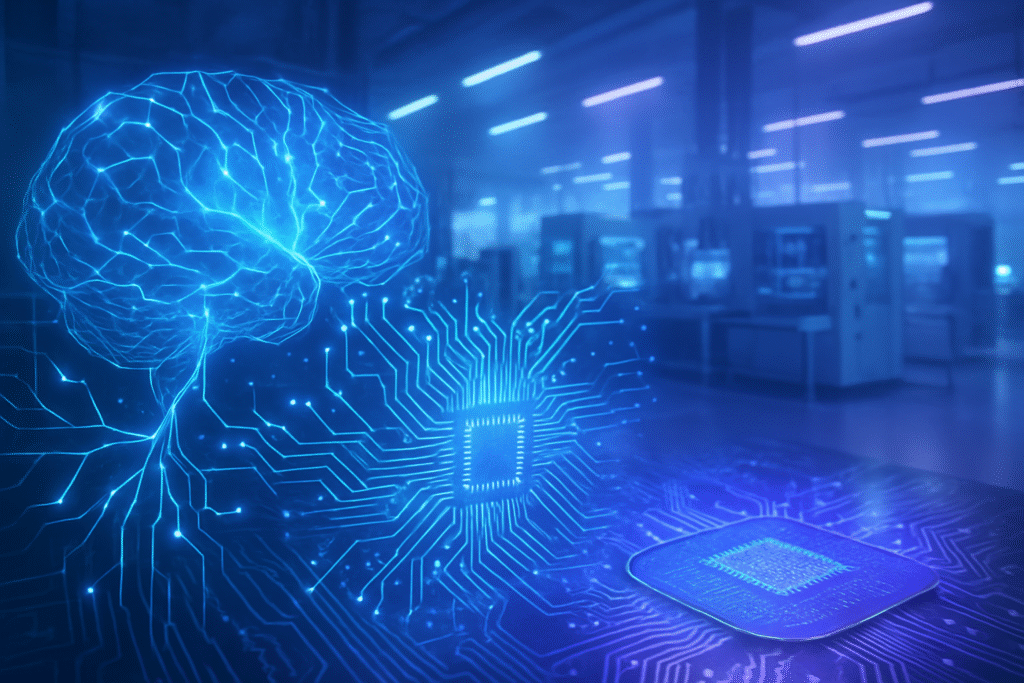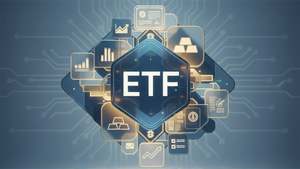
The semiconductor industry is experiencing an unprecedented surge, fundamentally reshaped by the pervasive integration of Artificial Intelligence across every stage, from intricate chip design to advanced manufacturing and diverse applications. As of October 2025, AI is not merely an enhancement but the indispensable backbone driving innovation, efficiency, and exponential growth, propelling the global semiconductor market towards an anticipated $697 billion in 2025. This profound symbiotic relationship sees AI not only demanding ever more powerful chips but also empowering the very creation of these advanced silicon marvels, accelerating development cycles, optimizing production, and unlocking novel device functionalities.
In chip design, AI-driven Electronic Design Automation (EDA) tools have emerged as game-changers, leveraging machine learning and generative AI to automate complex tasks like schematic generation, layout optimization, and defect prediction, drastically compressing design cycles. Tools like Synopsys' (NASDAQ: SNPS) DSO.ai have reportedly reduced 5nm chip design optimization from six months to just six weeks, marking a 75% reduction in time-to-market. Beyond speed, AI enhances design quality by exhaustively exploring billions of transistor arrangements and routing topologies and is crucial for detecting hardware Trojans with 97% accuracy, securing the supply chain. Concurrently, AI's impact on manufacturing is equally transformative, with AI-powered predictive maintenance anticipating equipment failures to minimize downtime and save costs, and advanced algorithms optimizing processes to achieve up to 30% improvement in yields and 95% accuracy in defect detection. This integration extends to supply chain management, where AI optimizes logistics and forecasts demand to build more resilient networks. The immediate significance of this AI integration is evident in the burgeoning demand for specialized AI accelerators—GPUs, NPUs, and ASICs—that are purpose-built for machine learning workloads and are projected to drive the AI chip market beyond $150 billion in 2025. This "AI Supercycle" fuels an era where semiconductors are not just components but the very intelligence enabling everything from hyperscale data centers and cutting-edge edge computing devices to the next generation of AI-infused consumer electronics.
The Silicon Architects: AI's Technical Revolution in Chipmaking
AI has profoundly transformed semiconductor chip design and manufacturing by enabling unprecedented automation, optimization, and the exploration of novel architectures, significantly accelerating development cycles and enhancing product quality. In chip design, AI-driven Electronic Design Automation (EDA) tools have become indispensable. Solutions like Synopsys' (NASDAQ: SNPS) DSO.ai and Cadence (NASDAQ: CDNS) Cerebrus leverage machine learning algorithms, including reinforcement learning, to optimize complex designs for power, performance, and area (PPA) at advanced process nodes such as 5nm, 3nm, and the emerging 2nm. This differs fundamentally from traditional human-centric design, which often treats components separately and relies on intuition. AI systems can explore billions of possible transistor arrangements and routing topologies in a fraction of the time, leading to innovative and often "unintuitive" circuit patterns that exhibit enhanced performance and energy efficiency characteristics. For instance, Synopsys (NASDAQ: SNPS) reported that DSO.ai reduced the design optimization cycle for a 5nm chip from six months to just six weeks, representing a 75% reduction in time-to-market. Beyond optimizing traditional designs, AI is also driving the creation of entirely new semiconductor architectures tailored for AI workloads, such as neuromorphic chips, which mimic the human brain for vastly lower energy consumption in AI tasks.
In semiconductor manufacturing, AI advancements are revolutionizing efficiency, yield, and quality control. AI-powered real-time monitoring and predictive analytics have become crucial in fabrication plants ("fabs"), allowing for the detection and mitigation of issues at speeds unattainable by conventional methods. Advanced machine learning models analyze vast datasets from optical inspection systems and electron microscopes to identify microscopic defects that are invisible to traditional inspection tools. TSMC (NYSE: TSM), for example, reported a 20% increase in yield on its 3nm production lines after implementing AI-driven defect detection technologies. Applied Materials (NASDAQ: AMAT) has introduced new AI-powered manufacturing systems, including the Kinex Bonding System for integrated die-to-wafer hybrid bonding with improved accuracy and throughput, and the Centura Xtera Epi System for producing void-free Gate-All-Around (GAA) transistors at 2nm nodes, significantly boosting performance and reliability while cutting gas use by 50%. These systems move beyond manual or rule-based process control, leveraging AI to analyze comprehensive manufacturing data (far exceeding the 5-10% typically analyzed by human engineers) to identify root causes of yield degradation and optimize process parameters autonomously.
Initial reactions from the AI research community and industry experts are overwhelmingly positive, acknowledging these AI advancements as "indispensable for sustainable AI growth." Experts from McKinsey & Company note that the surge in generative AI is pushing the industry to innovate faster, approaching a "new S-curve" of technological advancement. However, alongside this optimism, concerns persist regarding the escalating energy consumption of AI and the stability of global supply chains. The industry is witnessing a significant shift towards an infrastructure and energy-intensive build-out, with the "AI designing chips for AI" approach becoming standard to create more efficient hardware. Projections for the global semiconductor market nearing $800 billion in 2025, with the AI chip market alone surpassing $150 billion, underscore the profound impact of AI. Emerging trends also include the use of AI to bolster chip supply chain security, with University of Missouri researchers developing an AI-driven method that achieves 97% accuracy in detecting hidden hardware trojans in chip designs, a critical step beyond traditional, time-consuming detection processes.
Reshaping the Tech Landscape: Impact on AI Companies, Tech Giants, and Startups
The increasing integration of AI in the semiconductor industry is profoundly reshaping the technological landscape, creating a symbiotic relationship where AI drives demand for more advanced chips, and these chips, in turn, enable more powerful and efficient AI systems. This transformation, accelerating through late 2024 and 2025, has significant implications for AI companies, tech giants, and startups alike. The global AI chip market alone is projected to surpass $150 billion in 2025 and is anticipated to reach $460.9 billion by 2034, highlighting the immense growth and strategic importance of this sector.
AI companies are directly impacted by advancements in semiconductors as their ability to develop and deploy cutting-edge AI models, especially large language models (LLMs) and generative AI, hinges on powerful and efficient hardware. The shift towards specialized AI chips, such as Application-Specific Integrated Circuits (ASICs), neuromorphic chips, in-memory computing, and photonic chips, offers unprecedented levels of efficiency, speed, and energy savings for AI workloads. This allows AI companies to train larger, more complex models faster and at lower operational costs. Startups like Cerebras and Graphcore, which specialize in AI-dedicated chips, have already disrupted traditional markets and attracted significant investments. However, the high initial investment and operational costs associated with developing and integrating advanced AI systems and hardware remain a challenge for some.
Tech giants, including Alphabet (NASDAQ: GOOGL), Amazon (NASDAQ: AMZN), Microsoft (NASDAQ: MSFT), and Apple (NASDAQ: AAPL), are heavily invested in the AI semiconductor race. Many are developing their own custom AI accelerators, such as Google's (NASDAQ: GOOGL) Tensor Processing Units (TPUs), Amazon Web Services (AWS) Graviton, Trainium, and Inferentia processors, and Microsoft's (NASDAQ: MSFT) Azure Maia 100 AI accelerator and Azure Cobalt 100 cloud CPU. This strategy provides strategic independence, allowing them to optimize performance and cost for their massive-scale AI workloads, thereby disrupting the traditional cloud AI services market. Custom silicon also helps these giants reduce reliance on third-party processors and enhances energy efficiency for their cloud services. For example, Google's (NASDAQ: GOOGL) Axion processor, its first custom Arm-based CPU for data centers, offers approximately 60% greater energy efficiency compared to conventional CPUs. The demand for AI-optimized hardware is driving these companies to continuously innovate and integrate advanced chip architectures.
AI integration in semiconductors presents both opportunities and challenges for startups. Cloud-based design tools are lowering barriers to entry, enabling startups to access advanced resources without substantial upfront infrastructure investments. This accelerated chip development process makes semiconductor ventures more appealing to investors and entrepreneurs. Startups focusing on niche, ultra-efficient solutions like neuromorphic computing, in-memory processing, or specialized photonic AI chips can disrupt established players, especially for edge AI and IoT applications where low power and real-time processing are critical. Examples of such emerging players include Tenstorrent and SambaNova Systems, specializing in high-performance AI inference accelerators and hardware for large-scale deep learning models, respectively. However, startups face the challenge of competing with well-established companies that possess vast datasets and large engineering teams.
Companies deeply invested in advanced chip design and manufacturing are the primary beneficiaries. NVIDIA (NASDAQ: NVDA) remains the undisputed market leader in AI GPUs, holding approximately 80-85% of the AI chip market. Its H100 and next-generation Blackwell architectures are crucial for training large language models (LLMs), ensuring sustained high demand. NVIDIA's (NASDAQ: NVDA) brand value nearly doubled in 2025 to USD 87.9 billion due to high demand for its AI processors. TSMC (NYSE: TSM), as the world's largest dedicated semiconductor foundry, manufactures the advanced chips for major clients like NVIDIA (NASDAQ: NVDA), Apple (NASDAQ: AAPL), AMD (NASDAQ: AMD), and Amazon (NASDAQ: AMZN). It reported a record 39% jump in third-quarter profit for 2025, with its high-performance computing (HPC) division contributing over 55% of its total revenues. TSMC's (NYSE: TSM) advanced node capacity (3nm, 5nm, 2nm) is sold out for years, driven primarily by AI demand. AMD (NASDAQ: AMD) is emerging as a strong challenger in the AI chip market with its Instinct MI300X and upcoming MI350 accelerators, securing significant multi-year agreements. AMD's (NASDAQ: AMD) data center and AI revenue grew 80% year-on-year, demonstrating success in penetrating NVIDIA's (NASDAQ: NVDA) market. Intel (NASDAQ: INTC), despite facing challenges in the AI chip market, is making strides with its 18A process node expected in late 2024/early 2025 and plans to ship over 100 million AI PCs by the end of 2025. Intel (NASDAQ: INTC) also develops neuromorphic chips like Loihi 2 for energy-efficient AI. Qualcomm (NASDAQ: QCOM) leverages AI to develop chips for next-generation applications, including autonomous vehicles and immersive AR/VR experiences. EDA Tool Companies like Synopsys (NASDAQ: SNPS) and Cadence (NASDAQ: CDNS) are revolutionizing chip design with AI-driven tools, significantly reducing design cycles.
The competitive landscape is intensifying significantly. Major AI labs and tech companies are in an "AI arms race," recognizing that those with the resources to adopt or develop custom hardware will gain a substantial edge in training larger models, deploying more efficient inference, and reducing operational costs. The ability to design and control custom silicon offers strategic advantages like tailored performance, cost efficiency, and reduced reliance on external suppliers. Companies that fail to adapt their hardware strategies risk falling behind. Even OpenAI is reportedly developing its own custom AI chips, collaborating with semiconductor giants like Broadcom (NASDAQ: AVGO) and TSMC (NYSE: TSM), aiming for readiness by 2026 to enhance efficiency and control over its AI hardware infrastructure.
The shift towards specialized, energy-efficient AI chips is disrupting existing products and services by enabling more powerful and efficient AI integration. Neuromorphic and in-memory computing solutions will become more prevalent in specialized edge AI applications, particularly in IoT, automotive, and robotics, where low power and real-time processing are paramount, leading to far more capable and pervasive AI tasks on battery-powered devices. AI-enabled PCs are projected to make up 43% of all PC shipments by the end of 2025, transforming personal computing with features like Microsoft (NASDAQ: MSFT) Co-Pilot and Apple's (NASDAQ: AAPL) AI features. Tech giants developing custom silicon are disrupting the traditional cloud AI services market by offering tailored, cost-effective, and higher-performance solutions for their own massive AI workloads. AI is also optimizing semiconductor manufacturing processes, enhancing yield, reducing downtime through predictive maintenance, and improving supply chain resilience by forecasting demand and mitigating risks, leading to operational cost reductions and faster recovery from disruptions.
Strategic advantages are clear for companies that effectively integrate AI into semiconductors: superior performance and efficiency from specialized AI chips, reduced time-to-market due to AI-driven EDA tools, customization capabilities for specific application needs, and operational cost reductions between 15% and 25% through AI-driven automation and analytics. Companies like NVIDIA (NASDAQ: NVDA), with its established ecosystem, and TSMC (NYSE: TSM), with its technological moat in advanced manufacturing, maintain market leadership. Tech giants designing their own chips gain control over their hardware infrastructure, ensuring optimized performance and cost for their proprietary AI workloads. Overall, the period leading up to and including October 2025 is characterized by an accelerating shift towards specialized AI hardware, with significant investments in new manufacturing capacity and R&D. While a few top players are capturing the majority of economic profit, the entire ecosystem is being transformed, fostering innovation, but also creating a highly competitive environment.
The Broader Canvas: AI in Semiconductors and the Global Landscape
The integration of Artificial Intelligence (AI) into the semiconductor industry represents a profound and multifaceted transformation, acting as both a primary consumer and a critical enabler of advanced AI capabilities. This symbiotic relationship is driving innovation across the entire semiconductor value chain, with significant impacts on the broader AI landscape, economic trends, geopolitical dynamics, and introducing new ethical and environmental concerns.
AI is being integrated into nearly every stage of the semiconductor lifecycle, from design and manufacturing to testing and supply chain management. AI-driven Electronic Design Automation (EDA) tools are revolutionizing chip design by automating and optimizing complex tasks like floorplanning, circuit layout, routing schemes, and logic flows, significantly reducing design cycles. In manufacturing, AI enhances efficiency and reduces costs through real-time monitoring, predictive analytics, and defect detection, leading to increased yield rates and optimized material usage. AI also optimizes supply chain management, improving logistics, demand forecasting, and risk management. The surging demand for AI is driving the development of specialized AI chips like GPUs, TPUs, NPUs, and ASICs, designed for optimal performance and energy efficiency in AI workloads.
AI integration in semiconductors is a cornerstone of several broader AI trends. It is enabling the rise of Edge AI and Decentralization, with chips optimized for local processing on devices in autonomous vehicles, industrial automation, and augmented reality. This synergy is also accelerating AI for Scientific Discovery, forming a virtuous cycle where AI tools help create advanced chips, which in turn power breakthroughs in personalized medicine and complex simulations. The explosion of Generative AI and Large Language Models (LLMs) is driving unprecedented demand for computational power, fueling the semiconductor market to innovate faster. Furthermore, the industry is exploring New Architectures and Materials like chiplets, neuromorphic computing, and 2D materials to overcome traditional silicon limitations.
Economically, the global semiconductor market is projected to reach nearly $700 billion in 2025, with AI technologies accounting for a significant share. The AI chip market alone is projected to surpass $150 billion in 2025, leading to substantial economic profit. Technologically, AI accelerates the development of next-generation chips, while advancements in semiconductors unlock new AI capabilities, creating a powerful feedback loop. Strategically and geopolitically, semiconductors, particularly AI chips, are now viewed as critical strategic assets. Geopolitical competition, especially between the United States and China, has led to export controls and supply chain restrictions, driving a shift towards regional manufacturing ecosystems and a race for technological supremacy, creating a "Silicon Curtain."
However, this transformation also raises potential concerns. Ethical AI in Hardware is a new challenge, ensuring ethical considerations are embedded from the hardware level upwards. Energy Consumption is a significant worry, as AI technologies are remarkably energy-intensive, with data centers consuming a growing portion of global electricity. TechInsights forecasts a 300% increase in CO2 emissions from AI accelerators alone between 2025 and 2029. Job Displacement due to automation in manufacturing is a concern, though AI is also expected to create new job opportunities. Complex legal questions about inventorship, authorship, and ownership of Intellectual Property (IP) arise with AI-generated chip designs. The exorbitant costs could lead to Concentration of Power among a few large players, and Data Security and Privacy are paramount with the analysis of vast amounts of sensitive design and manufacturing data.
The current integration of AI in semiconductors marks a profound milestone, distinct from previous AI breakthroughs. Unlike earlier phases where AI was primarily a software layer, this era is characterized by the sheer scale of computational resources deployed and AI's role as an active "co-creator" in chip design and manufacturing. This symbiotic relationship creates a powerful feedback loop where AI designs better chips, which then power more advanced AI, demanding even more sophisticated hardware. This wave represents a more fundamental redefinition of AI's capabilities, analogous to historical technological revolutions, profoundly reshaping multiple sectors by enabling entirely new paradigms of intelligence.
The Horizon of Innovation: Future Developments in AI and Semiconductors
The integration of Artificial Intelligence (AI) into the semiconductor industry is rapidly accelerating, promising to revolutionize every stage of the chip lifecycle from design and manufacturing to testing and supply chain management. This symbiotic relationship, where AI both demands advanced chips and helps create them, is set to drive significant advancements in the near term (up to 2030) and beyond.
In the coming years, AI will become increasingly embedded in semiconductor operations, leading to faster innovation, improved efficiency, and reduced costs. AI-Powered Design Automation will see significant enhancements through generative AI and machine learning, automating complex tasks like layout optimization, circuit design, verification, and testing, drastically cutting design cycles. Google's (NASDAQ: GOOGL) AlphaChip, which uses reinforcement learning for floorplanning, exemplifies this shift. Smart Manufacturing and Predictive Maintenance in fabs will leverage AI for real-time process control, anomaly detection, and yield enhancement, reducing costly downtime by up to 50%. Advanced Packaging and Heterogeneous Integration will be optimized by AI, crucial for technologies like 3D stacking and chiplet-based architectures. The demand for Specialized AI Chips (HPC chips, Edge AI semiconductors, ASICs) will skyrocket, and neuromorphic computing will enable more energy-efficient AI processing. AI will also enhance Supply Chain Optimization for greater resilience and efficiency. The semiconductor market is projected to reach $1 trillion by 2030, with AI and automotive electronics as primary growth drivers.
Looking beyond 2030, AI's role will deepen, leading to more fundamental transformations. A profound long-term development is the emergence of AI systems capable of designing other AI chips, creating a "virtuous cycle." AI will play a pivotal role in New Materials Discovery for advanced nodes and specialized applications. Quantum-Enhanced AI (Quantum-EDA) is predicted, where quantum computing will enhance AI simulations. Manufacturing processes will become highly autonomous and Self-Optimizing Manufacturing Ecosystems, with AI models continuously refining fabrication parameters.
The breadth of AI's application in semiconductors is expanding across the entire value chain: automated layout generation, predictive maintenance for complex machinery, AI-driven analytics for demand forecasting, accelerating the research and development of new high-performance materials, and the design and optimization of purpose-built chips for AI workloads, including GPUs, NPUs, and ASICs for edge computing and high-performance data centers.
Despite the immense potential, several significant challenges must be overcome. High Initial Investment and Operational Costs for advanced AI systems remain a barrier. Data Scarcity and Quality, coupled with proprietary restrictions, hinder effective AI model training. A Talent Gap of interdisciplinary professionals proficient in both AI algorithms and semiconductor technology is a significant hurdle. The "black-box" nature of some AI models creates challenges in Interpretability and Validation. As transistor sizes approach atomic dimensions, Physical Limitations like quantum tunneling and heat dissipation require AI to help navigate these fundamental limits. The resource-intensive nature of chip production and AI models raises Sustainability and Energy Consumption concerns. Finally, Data Privacy and IP Protection are paramount when integrating AI into design workflows involving sensitive intellectual property.
Industry leaders and analysts predict a profound and accelerating transformation. Jensen Huang, CEO of NVIDIA (NASDAQ: NVDA), and other experts emphasize the symbiotic relationship where AI is both the ultimate consumer and architect of advanced chips. Huang predicts an "Agentic AI" boom, demanding 100 to 1,000 times more computing resources, driving a multi-trillion dollar AI infrastructure boom. By 2030, the primary AI computing workload will shift from model training to inference, favoring specialized hardware like ASICs. AI tools are expected to democratize chip design, making it more accessible. Foundries will expand their role to full-stack integration, leveraging AI for continuous energy efficiency gains. Companies like TSMC (NYSE: TSM) are already using AI to boost energy efficiency, classify wafer defects, and implement predictive maintenance. The industry will move towards AI-driven operations to achieve exponential scale, processing vast amounts of manufacturing data that human engineers cannot.
A New Era of Intelligence: The AI-Semiconductor Nexus
The integration of Artificial Intelligence (AI) into the semiconductor industry marks a profound transformation, moving beyond incremental improvements to fundamentally reshaping how chips are designed, manufactured, and utilized. This "AI Supercycle" is driven by an insatiable demand for powerful processing, fundamentally changing the technological and economic landscape.
AI's pervasive influence is evident across the entire semiconductor value chain. In chip design, generative AI and machine learning algorithms are automating complex tasks, optimizing circuit layouts, accelerating simulations and prototyping, and significantly reducing design cycles from months to mere weeks. In manufacturing, AI revolutionizes fabrication processes by improving precision and yield through predictive maintenance, AI-enhanced defect detection, and optimized manufacturing parameters. In testing and verification, AI enhances chip reliability by identifying potential weaknesses early. Beyond production, AI is optimizing the notoriously complex semiconductor supply chain through accurate demand forecasting, intelligent inventory management, and logistics optimization. The burgeoning demand for specialized AI chips—including GPUs, specialized AI accelerators, and ASICs—is the primary catalyst for this industry boom, driving unprecedented revenue growth. Despite the immense opportunities, challenges persist, including high initial investment and operational costs, a global talent shortage, and geopolitical tensions.
This development represents a pivotal moment, a foundational shift akin to a new industrial revolution. The deep integration of AI in semiconductors underscores a critical trend in AI history: the intrinsic link between hardware innovation and AI progress. The emergence of "chips designed by AI" is a game-changer, fostering an innovation flywheel where AI accelerates chip design, which in turn powers more sophisticated AI capabilities. This symbiotic relationship is crucial for scaling AI from autonomous systems to cutting-edge AI processing across various applications.
Looking ahead, the long-term impact of AI in semiconductors will usher in a world characterized by ubiquitous AI, where intelligent systems are seamlessly integrated into every aspect of daily life and industry. This AI investment phase is still in its nascent stages, suggesting a sustained period of growth that could last a decade or more. We can expect the continued emergence of novel architectures, including AI-designed chips, self-optimizing "autonomous fabs," and advancements in neuromorphic and quantum computing. This era signifies a strategic repositioning of global technological power and a redefinition of technological progress itself. Addressing sustainability will become increasingly critical, and the workforce will see a significant evolution, with engineers needing to adapt their skill sets.
The period from October 2025 onwards will be crucial for observing several key developments. Anticipate further announcements from leading chip manufacturers like NVIDIA (NASDAQ: NVDA), Intel (NASDAQ: INTC), and AMD (NASDAQ: AMD) regarding their next-generation AI accelerators and architectures. Keep an eye on the continued aggressive expansion of advanced packaging technologies and the surging demand for High-Bandwidth Memory (HBM). Watch for new strategic partnerships between AI developers, semiconductor manufacturers, and equipment suppliers. The influence of geopolitical tensions on semiconductor production and distribution will remain a critical factor, with efforts towards supply chain regionalization. Look for initial pilot programs and further investments towards self-optimizing factories and the increasing adoption of AI at the edge. Monitor advancements in energy-efficient chip designs and manufacturing processes as the industry grapples with the significant environmental footprint of AI. Finally, investors will closely watch the sustainability of high valuations for AI-centric semiconductor stocks and any shifts in competitive dynamics. Industry conferences in the coming months will likely feature significant announcements and insights into emerging trends. The semiconductor industry, propelled by AI, is not just growing; it is undergoing a fundamental re-architecture that will dictate the pace and direction of technological progress for decades to come.
This content is intended for informational purposes only and represents analysis of current AI developments.
TokenRing AI delivers enterprise-grade solutions for multi-agent AI workflow orchestration, AI-powered development tools, and seamless remote collaboration platforms.
For more information, visit https://www.tokenring.ai/.





